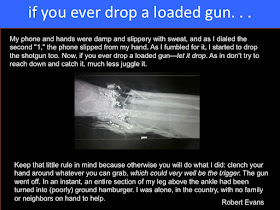 |
| Down 3 Points |
Research
indicates that criminals often choose the darkness or low light conditions to
pursue their nefarious profession. A significant number of shootings involving
police officers happen at night as well. Criminals view darkness as an asset
and use it as an advantage against those whom they would victimize. These
realities mean that if you are forced to defend yourself odds are it will be
under low light conditions; however, few people pursue low light training even
where the opportunity exists.
We’ve finished
the Low Light Classes and practices for the year. Although shooting accurately
with a flashlight is much more challenging than simply using a normal
two-handed stance, our shooter’s improvement over the past several years is
impressive. Accurate shot placement is becoming the norm rather than the
exception.
This session we
fired the modified Texas LTC qualification course. We stayed within Texas LTC
time limits; however, we used an anatomically correct picture target and scored
based upon the hit’s probable effectiveness (i.e. central nervous and critical
circulatory system hits counted higher that lung hits). In some cases, this
meant that a shooter who didn’t have a perfect group actually earned an acceptable
score. Shooters started all strings of fire with flashlight in hand, drawing
from the holster with the exception of the 2 second strings.
The second
qualification was the Texas Department of Public Safety qualification course.
This course of fire is much more involved and challenging than the LTC
qualification with some movement, reloads, and distances out to 25 yards. (see video)
We’ve learned
that practice shooting and manipulating the pistol with the light in hand and
recovering the light dangling from the lanyard (reloading) is crucial. Happily,
this can be done in daylight on the range and in our dry fire practice. Although shooters
initially tend to discount the Rogers/Cigar/Syringe (call it what you wish)
technique, they often find that it is necessary to use it while shooting around
the side of cover to prevent unacceptable reflection.
You must practice low light techniques to have any hope of
using them under
stress. As we’ve discovered, students simply don’t master the low light
techniques from class--you cannot practice it once and get it down pat. Using a
light in conjunction with a handgun is difficult and it requires practice.
Thankfully you can practice the techniques with live fire during daylight if
your range won’t allow night shooting.
So how do you
practice engaging multiple and shooting on the move with these techniques? If
your local range has IDPA matches, shoot the course of fire using your
flashlight if the match director will permit it. Your score won’t win the
match; however, you will learn how to shoot and manipulate your pistol under
some stress. Practicing how to search a structure (like your house when nobody
is home) in the dark is important as well. Do this with AN UNLOADED PISTOL
(check it 3 times!). This helps you identify how the various angles and corners
in your house make one technique a better option than the other.
There are several
reasons to use a flashlight: to observe and detect, to illuminate and navigate,
to eliminate anonymity, and to identify and engage threats. Used properly, a
flashlight lets you see danger before it can affect you and it can encourage
the danger waiting in the dark to go elsewhere.
Click here to learn more about low light shooting techniques
Click here to learn more about low light shooting techniques


